
Chapter 1
Psychometry & Time Travel with Ancient Beads

Mill Street Gallery featured thousands of ancient and medieval beads back in the day.
If you've ever wanted to contact a past life, ancient beads are a great and inexpensive way to make solid and powerful quantum connections. Since I acquired my ancient beads, which was from 1960-1989, I've been salting them away for psychometric use.
Many of the more expensive beads went into Jewels of Ancient Lands productions, sold many years ago in Beverly Hills, San Francisco, New York & Atlanta jewelry boutiques for many thousands of dollars.
Those fabulous ancient and medieval glass and stone beads are long-gone, and cannot be repeated. The bead market that came out of Mali, Africa, has vanished forever -- all you'll find at that once-great international bead market are beads coming out of other places, notably Pakistan, China and Ethiopia.
My longtime friend and fellow bead trader Liza Wataghani is unarguably one of the greatest bead traders of the present century, and the world's greatest expert on coral in various cultures, and her personal experience with the Mali Bead Market goes back to the 1960s, as does mine; she will tell you how the bead market went down forever, when the local beads from the Djenne Trade Route were entirely depleted. There haven't been any new finds for the past 30 years in Mali, and none are expected anytime, ever, especially with the political situation being what it is today.
The quality of the beads coming out of the Mali and Ethiopian bead markets are quite good even in today's weary and over-exploited bead market. They're okay, as I said, but they're nothing like the incredible beads we used to see back in the 1960s, when my bead collecting and trading was at an all-time high -- I've built several collections for museums, and it's almost impossible today to assemble anything serious with what's available today.
If I wanted more ancient beads -- I don't, I have more than I can handle now -- I'd have to take my chances on eBay, and the selection seems okay, seems attractive, but the prices are much higher than I want to pay, much higher than trade show retail, and the beads are, even though authentic, not nearly the quality of the earlier trade beads.
The THOUSANDS OF FAKES on eBay make it very risky, and often you have to put the bead under a loupe in person to be able to detect the counterfeit. I'd not tend to trust the dealers to know the difference between an ancient and a counterfeit, even with a microscope to lean upon. It's just too close a call, and SOME of them are okay, and some are not.
The fakes are very well made, and huge governments are money are behind the counterfeiters, because they want US currency, and they want it badly enough to do almost anything to get hold of it, even if the LOSE money in the process of gaining US dollars.
Most of the HONEST bead dealers and collectors haven't had enough beads through their hands to really KNOW the difference between an Islamic cobalt and a Roman cobalt glass bead. You have to handle, actually handle, hundreds of thousands of individual beads and thousands and thousands of strung beads, to really really KNOW the difference, because it's truly subtle.
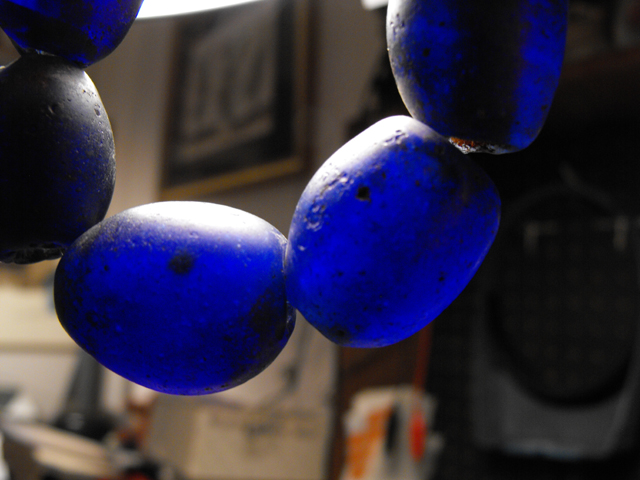
Large Ancient Blue Cobalt Beads are common to many sites around the ancient world.
I keep in a sealed case two PROVEN excavation beads, both deep blue cobalt glass, both from marked & recorded excavations, and they look alike, even under a loupe. How can you tell the difference between them? Only by the fact that one is tagged from one site, and the other is tagged from the other site.
Other than my own diligence and the fact that they arrived encased, there is no way to tell them apart except perhaps by a series of laboratory tests including Carbon-14 breakdown and spectrometer, and I'd still have my doubts that somehow the beads got mixed up.
The same beads were made for hundreds and even thousands of years, often by the same family. The secrets of glass-making, mold-making, jewelry and stone cutting were passed down from father to son, typically, throughout the ages, until Medieval times, when the apprentice system became popular, along with the indentured servant, and they were often combined into one legal agreement.
In exchange for food and board and a small stipend, a youngster could learn from a master and then take over the trade when the master was no longer able to conduct business. This had previously been the place-marker reserved for the eldest son, but sometimes a daughter would inherit, hopefully having observed the secrets for a long enough time that she was able to carry on.

My little gallery on Broad Street in Nevada City flourished in the 1980s.
Normally, girls were not taught these secrets, and today in some nations and under some severe and very psychotic controlling cultures, women are not permitted to perform artistic tasks, just the usual grim household chores, crawling around in the presence of men.
Strangely, that was the very practice which led to the decay of every culture that went down in the past. Women are necessary and they are needed in important roles, from politics to finance to education all the way to the ultimate, religion. It's Priestess Time from now on, so get used to it.
Beads were the first money, did you know that?
There had to be a way to compress wealth and carry it around, short of hauling dozens of wheat baskets around with you on the back of a donkey whenever you went to market. Fortunately I can illustrate this easily with a short vid I made on my ancient cellphone:
"Gimme a Clark's bar, and a Honey Bits, and a Mars bar and a large cherry cola and a large popcorn with butter and another Mars bar. Can I pay you with this pig?"
"Sure. Here's your change, a chicken and three large eggs."
See how unwieldy that can be? So somewhere around 4500 B.C. someone said "Let there be money," and behold, there was money, in the form of shell beads, stone beads, wooden beads, natural holed objects and the ever-popular bone beads -- don't even ask.

Only one of these ancient beads is worth collecting. Can you tell which one it is?
Sometimes, actually quite often, back in the sixties, I bought an entire strand of beads at the Mali bead market just to get hold of the one bead I actually wanted, then had to sell off the remainder, and that's mostly what you'll find that I have for sale, are the beads I didn't use or won't use in the foreseeable future.
I don't trade in important antiquities. Just about everything I have is available for a price on eBay or the other bead trading sites, but the prices are far and away above what I can bring myself to ask for a bead, although I often paid whatever I had to in order to get the beads I wanted to work with.
I collected beads primarily to keep them off the casual trade market, and they have survived quite well in my hands, and hopefully some of them will in yours.
It would be great to have someone step up and say, "I'd like to support a museum for these ancient beads," and pay the rental on a place for the next ten years until a building gets donated for the project, but that probably won't happen, because beads are not considered important enough to justify a whole museum for them, but they are important, and that was why I collected them in the first place, but as I said, nobody has yet stepped up to the plate.
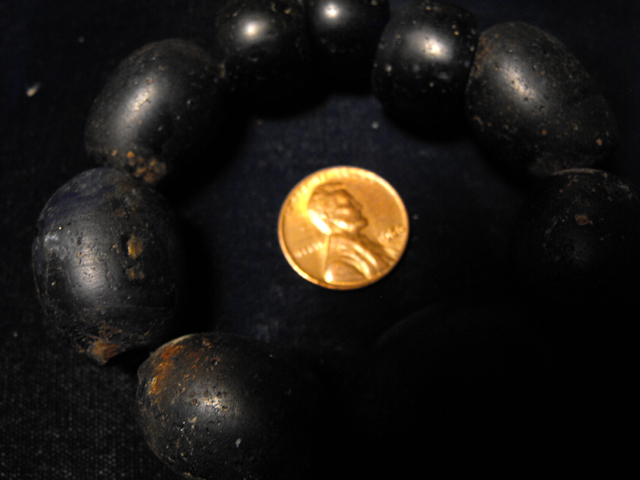
Extremely rare Black Copal beads date to the Roman Republic, about 100 B.C.
The museum-grade beads in my collection are not for sale. I curate them in hopes of having a good home for them while I'm still able to design the space and write the exhibit notes.
That's another thing; the market has taken over the scholarship to such a degree that the marketplace decrees a bead to be from one culture and scholars lose the argument, because money talks louder than knowledge. There's a lot of Urban Legend about beads that just isn't true.
Most of the African trade beads are not from Africa. You need to know this if you're going to trade them, and there are SO many fakes out there now, including DZI beads and many other rarities.
A wee bit about STRUNG African Trade Beads -- first, make sure it's the original stringing, then determine the EXACT beads in the string, looking for ancient beads. Most of the necklaces are passed along from generation to generation, going all the way back to ancient times, and amazingly, you'll find Sumerian and Babylonian beads once in a while!
So how did the Sumerian and Babylonian and Chinese and Indian and Other beads end up in Africa?
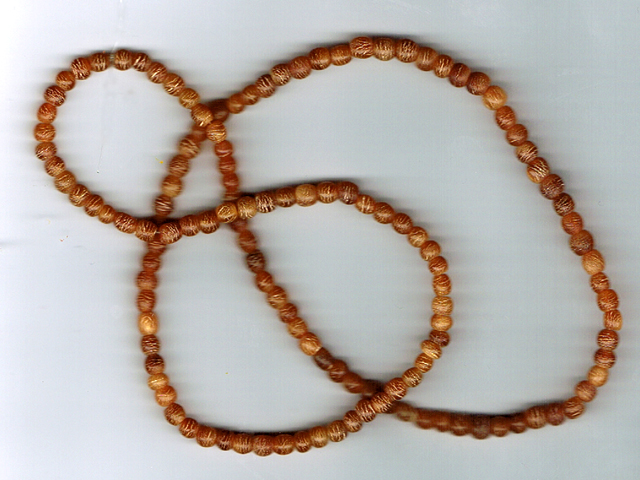
These Bohemian glass African Trade beads first appeared around 1600 AD, but this strand dates to about 1850 AD.
Beads have been traded since neolithic times, about 40,000 B.C., and there's plenty of evidence to back that up, where you'll find a stone or shell that couldn't possibly be from that region.
Thousands of Cherchin Man gravesites exist in the Taklamakan Desert of China, dating back to about 1300 B.C. and there were plenty of beads buried with them, many of which had traveled thousands of miles from the British Isles to ancient China.
Ancient Chinese beads can be found just about anywhere in Europe; Indian and Japanese beads, too. Bead trade along the Silk Trade Route was so common that it could have easily been dubbed the "Bead Trade Route" as well.
The principle goods were silks, beads, exotic foods and spices. Spices were important, because refrigeration didn't exist, and rotting foods such as meat needed the spices to make them palatable.
In addition, the Medieval Europeans needed aromatics, perfumes and spices, to combat evil and illness. Sickness was thought to spread by "bad air", or "humors", and posies were carried to ward off the Black Plague. Worked for me. Reincarnation is the best cure for serious ailments.
ALL of my collections of ancient beads, antiquities, antiquarian books and rare fine art have been intended to re-awaken memories of ancient times.
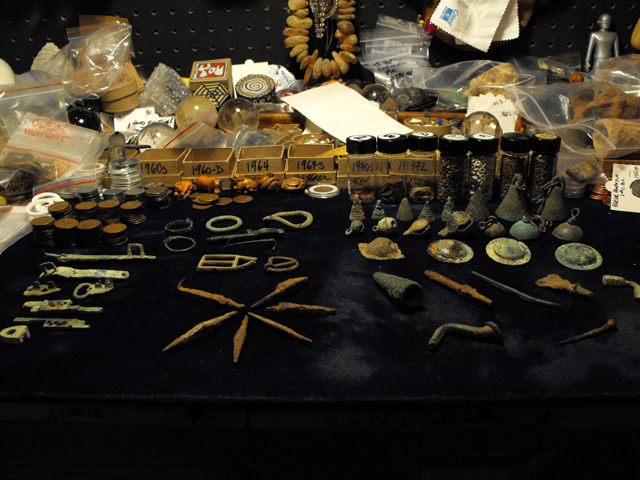
Re-awakening ancient memories extends your lifetime out over many lives and cultures, giving you a larger spiritual footprint.
When you actually WEAR something ancient, you remember what it FELT LIKE to be a Queen or a Scribe or a Laborer in ancient times. Wearing ancient Objects of Daily Use such as jewelry or beads requires a judgment call on the part of the jeweler -- many ancient items should not be worn, because they'll wear down or be ruined by skin contact, such as highly effluoresced glass or delicate faience.
I sell those only as collectibles, not wearables. What IS wearable? Certainly you'd be happy with the wearability of ancient carnelian, some of which is fabulous to behold, and some is just passable -- the latter being the affordable type.
I have many small ceramic beads that came from the North Palace at Amarna, the home of Akhenaten & Nefertiti and of course, King Tut, Tut-Ank-Amun, the boy-king whose gold funeral mask traveled around the world in a blockbuster museum show for which millions stood in line.
Why?
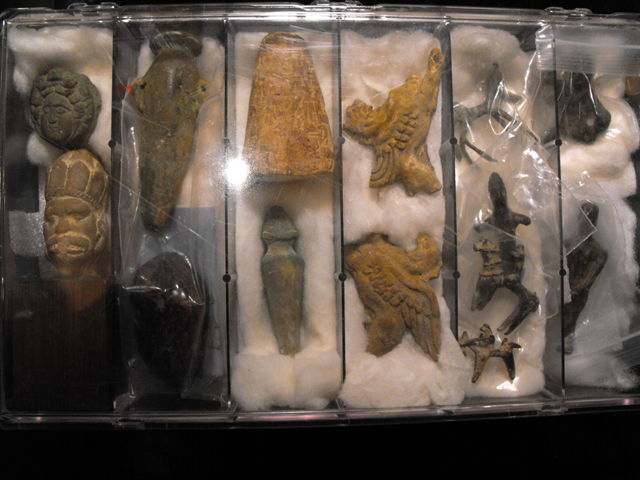
My earliest collection of antiquities was assembled in 1972, with the help of Joel Malter and Joe Rose.
The Mummy's Curse. Everyone involved in the excavation of the Tomb of King Tut died in some mysterious way -- at least that's what Mona Phillips' Dad, former head curator at the Cairo Museum had said in his bestseller book, "Tut's Curse", now almost unfindable in any condition -- the book, that is.
You don't even need to touch or hold these objects to get the quantum connection to ancient time-frames. Antiquity is there, always has been, always will be. Time is a connected series of still-frames.
Visiting ancient times is easy if all you want to do is take a look & listen.
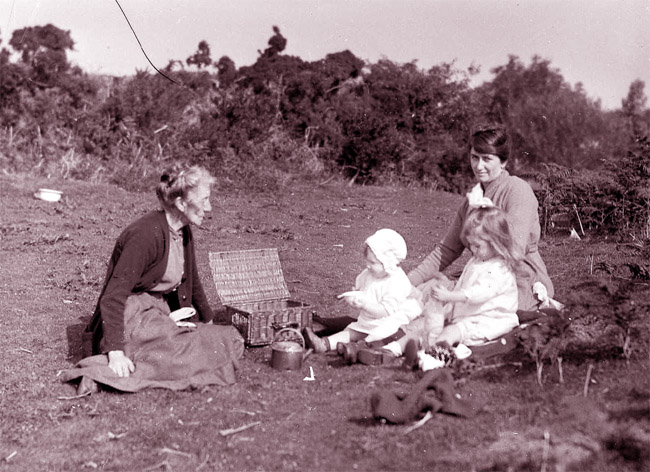
Is this Victorian Picnic a scene from one of YOUR past lives?
PLS -- "Past Life Survey" -- techniques are SO available now, and all you have to do is specify a time and place, and I probably have an Object of Daily Use that will connect you up with it, and generally, they're not expensive, just hard or impossible to find, is all.
Keep in mind as you search for your target location for your next PLS Past Life Survey that most of the articles offered on eBay are fakes, although they LOOK great, and they come from countries that are interested in accumulating US dollars.
Mine have been in the United States since around 1960-1980, and are of the NOT CULTURALLY IMPORTANT variety, meaning they're considered archaeological junk.
Don't let that deter you. If you're using antiquities as quantum connections to help you sort out your past life memories and visual flashes, you aren't trying to win any art collector awards, so ugly shouldn't matter, and unimportant surely would not be part of your calculation, nor would you be thinking of the marketplace for an object you've just used as part of your personal spiritual journey.
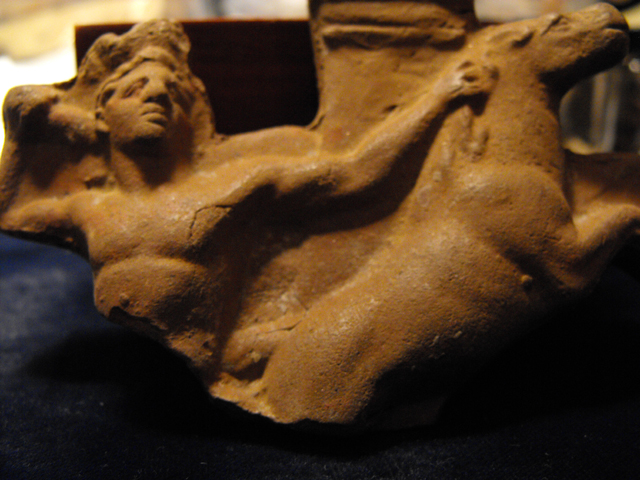
Contemporary portrait of Alexander the Great on horseback in battle, terra-cotta, at my gallery.
My beads are priced according to their current replacement values on eBay, relating ONLY to authentic beads. Lots of fakes are cheaper, and if you want fakes, fine, go get 'em, they're a total bargain, but they have no ancient VIBES, they just look good.
If all you want to do is LOOK right, you don't have to buy fake ancient or any of that. The beads that were made in antiquity are the same beads they make today, only today's beads are plastic or resin.
If you don't care about the ancient vibes, make something that LOOKS ancient and be happy.
I have a rather large collection of buttons, beads and other smallish and fairly inexpensive items from the Old West, plus a personal collection of Donner Party memorabilia, being reserved for a Donner House Museum & Gift Shop, with a PLS Training Center in the back, which I'm hoping someone will step forward and back and operate -- I have a site picked out for it already, if someone wants to take the big step forward.
Past Life Training Centers should be opening all over the world not that far in the future -- BardoMania will be HOT in the news for a long time to come. Get in on the Ground Floor while you still can!

